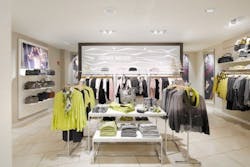Zumtobel validates Limbic theory with LED lighting at retailer Gerry Weber
SSL implementations matched to the typical personality of a shopper result in a 10% improvement in retail sales, verifying prior Limbic lighting research in the lab.
Zumtobel has announced the results of a field study using LED-based retail lighting to accent merchandise at fashion and lifestyle shop Gerry Weber. The study was focused on accessing the Limbic Emotional Assessment (LEA) theory that asserts a match between lighting preference and general personality traits that can be applied to boost retail sales. Zumtobel said the LED retail lighting project netted Gerry Weber a 10% boost in sales with solid-state lighting (SSL) tuned to the typical shopper.
We previously covered Limbic lighting based on a Zumtobel demonstration at Light+Building in the spring of 2014. The LEA theory was developed by Munich-based consultancy Gruppe Nymphenburg in partnership with Zumtobel. Limbic research in the lab showed that specific target groups organized by personality traits have affinity for different levels and spectral distribution in white light. The original research identified separate Balance, Stimulance, and Dominance groups with different preferences.
Zumtobel tested the theory at the Herford, Germany Gerry Weber shop. SSL matched to the Balance group was installed in the shop. The Balance group includes what the original research call harmonizers that prefer moderate accent lighting. The installed 3000K-CCT LED retail lighting was intended to "generate a bright and friendly atmosphere."
The trial shop was compared to a very similar reference location in terms of size, demographic, store design, and location. Lighting matched to the target preferences is the primary difference in the two stores yet the Limbic-lit store delivered the aforementioned 10% increase in sales.
The study certainly made an impression on the retailer. "For us as an international fashion brand, it was fascinating to see clear scientific findings that prove the significant influence of light at the POS [point of sale]," said Hörschläger Martin, head of retail operations at Gerry Weber. "The cooperation with Zumtobel was extremely positive and ultimately the key to us understanding and then responding to the light preferences of our target group. We have seen how profitable the Limbic lighting concept proved in our Herford store, with a marked increase in sales during the test period. In comparison with the reference store, the retail space with the optimized Limbic lighting solution achieved up to 10% more turnover."
The implicit revenue results in the test store indicated performance superior to stores across the retailer's portfolio. Moreover, the researchers asked explicit questions of some shoppers that revealed a generally positive attitude about the shop. The Limbic lighting is presumed to have led customers to spend more time in the store, to feel more relaxed, and ultimately to spend more on merchandise.
Limbic lighting is simply one of many LED-based technologies being pursued to boost retail sales. Lights with high CRI and high R9 ratings for saturated red color rendering can make goods look more enticing. And indoor positioning can lead shoppers to merchandise of interest and present shoppers with special incentives.
About the Author
Maury Wright
Editor in Chief
Maury Wright is an electronics engineer turned technology journalist, who has focused specifically on the LED & Lighting industry for the past decade. Wright first wrote for LEDs Magazine as a contractor in 2010, and took over as Editor-in-Chief in 2012. He has broad experience in technology areas ranging from microprocessors to digital media to wireless networks that he gained over 30 years in the trade press. Wright has experience running global editorial operations, such as during his tenure as worldwide editorial director of EDN Magazine, and has been instrumental in launching publication websites going back to the earliest days of the Internet. Wright has won numerous industry awards, including multiple ASBPE national awards for B2B journalism excellence, and has received finalist recognition for LEDs Magazine in the FOLIO Eddie Awards. He received a BS in electrical engineering from Auburn University.

